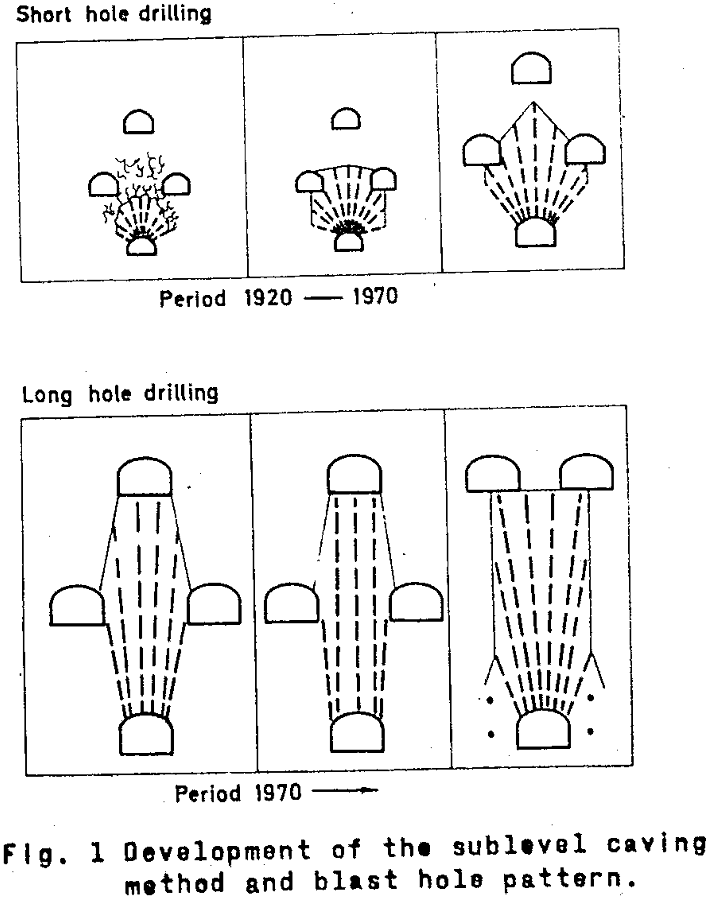Blasting Mechanics
The term “powder factor” is almost universally accepted as the measure of the efficiency of a blasting program. It represents the economics of blasting since it designates quantity of explosive (thereby providing quality control in rock fragmentation) in terms of the associated volume broken. It is the wide use of this concept that explains the […]
Functional Optimization of Open Pit Mine Design

In the development of the ultimate pit limits for a narrow ore body, parameters necessary in the design of a functional, or working, pit become highly sensitive factors in the determination of ore reserve levels and their associated waste to ore stripping ratios. Through the use of geologic cross sections, ore reserves can be roughly […]
Open Storage Piles and Dust Control
In discussing the open storage dust problem and possible solutions, one obvious question arises – what are the economics of placing large bulk storage under cover? Several known, practical, workable solutions to the open storage dust problem are described. These include the following which will be dealt with in some detail: A. Open pile surface crusting […]
Open Pit Equipment Selection and Maintenance

Principal factors influencing equipment selection can be grouped into five basic categories. Tonnage Requirements, Ore and Waste, Topography and Property Line Considerations, Ore Control Requirements, Physical Characteristics of Ore and Waste, and Climatic Conditions. Site Preparation Specialized Machines: This type of equipment generally operates on the principle of leverage uprooting and mechanical breakage of fallen vegetation. It is used in […]
Hydraulic Excavator
First, the hydraulic excavator enjoys tooth forces of the shovel because the dipper is attached to the machine with a dipperstick and boom, and can often actually realize greater tooth forces than a shovel because of the prize action of the dipper in hard digging. Digging range can be as deep as 35′ while dumping […]
Accident Prediction Techniques

The secret to accident prediction is to utilize the tendency for history to repeat itself. The same circumstances and the same human behavior that produced accidents in the past tend to produce accidents in the present and the future. The ability to predict accident occurrence in the future by projecting from the past is a […]
Sublevel Caving

Sublevel caving has created through its possibilities of standardizing and mechanizing operations and equipment. Other advantages are that the method can be adapted to orebodies of different shape, size, strength etc., and especially that working conditions can be made safe and relatively comfortable since all work is carried out in drifts. As is well known, the […]
Determining Air Requirements for Reverse Air Lift

Numerous large scale drilling projects have made use of reverse circulation air lift methods. Reverse air lift pumping can be established by injecting gas into a column of liquid; the subsequently decreased density of the gas-liquid mixture allows atmospheric pressure outside the lift conduit to establish flow. The rate of flow can be controlled by […]
Overburden Stripping using Dredge and Draglines

Texasgulf’s Lee Creek Mine in Eastern North Carolina is using a combination Dredge-Dragline method for mining deep phosphate ore at a rate of 3.5 million tons per year. The matrix is thick, uniform in grade, and is processed into agricultural products. As in many other good mineral deposits, there are tough obstacles to overcome in […]
Open Pit Design Economics

The economic limit of an open pit mining operation is dictated by three basic elements- cut-off grade, stripping ratio and slope angle. Although these elements are interrelated, they are functions of a number of independent parameters, which are too numerous to list completely. Simply stated, the following relationships are true: Economic Pit Limit = f […]
